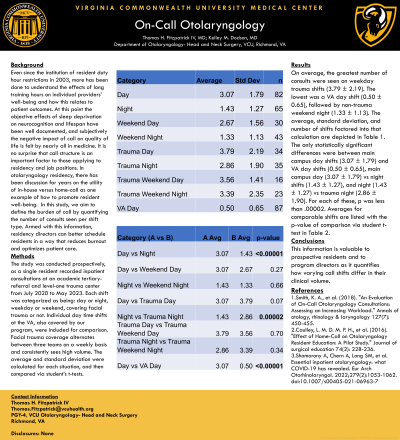Business of Medicine/Practice Management
(349) On Call Otolaryngology
Monday, October 2, 2023
2:45 PM - 3:45 PM East Coast USA Time

Has Audio

Thomas H. Fitzpatrick, IV, MD
Resident physician
Virginia Commonwealth University Health System
Richmond, Virginia, United States- KD
Kelley Dodson, MD
Virginia Commonwealth University Health System, USA
Presenting Author(s)
Senior Author(s)
Disclosure(s):
Thomas H. Fitzpatrick, MD, IV: No relevant relationships to disclose.
Introduction: To better understand resident schedules and work load, this study examines the rate of inpatient otolaryngology consults seen at an academic center.
Methods: The study was conducted prospectively, as a single resident recorded inpatient consultations at an academic tertiary-referral and level-one trauma center from July 2020 to September 2022. Each shift was categorized as being: day or night, weekday or weekend, covering facial trauma or not. Individual day time shifts at the VA, also covered by our program, were included for comparison. Facial trauma coverage alternates between three teams on a weekly basis and consistently sees high volume. The average and standard deviation were calculated for each situation, and then compared via student’s t-tests.
Results: On average, the greatest number of consults were seen on weekday trauma shifts (3.8 +/- 2.2), followed by trauma weekend day (3.4 +/- 1.4). The lowest was a VA day shift (0.5 +/- 0.7), followed by a non-trauma weeknight which was tied with a non-trauma weekend night (1.3). Generally, more consults were seen on the day than night, weekdays than weekends, and while covering trauma.
The only statistically significant differences found were between main campus day shifts (3.1) and VA day shifts (0.5), main campus day (3.1) vs night shifts (1.3), and night (1.3) vs trauma night (3.2). For each of these, p was less than .00001.
Conclusions: This information is valuable to prospective residents and to program directors as it quantifies how varying call shifts differ in their work load. Specifically, VA consults are less frequent than main campus ones, and trauma coverage greatly increases consultation volume.
